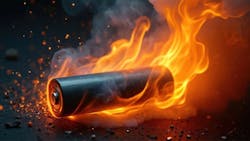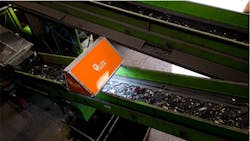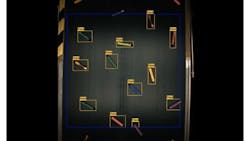Lion Vision (Manchester, ENG, UK), an AI software company, has developed an automated system to detect batteries in scrap from electrical and electronic equipment. Sweeep Kuusakoski (Sittingbourne, ENG, UK), an electrical and electronics recycling company, purchased the system and Lion Vision set it up in Sweeep’s Sittingbourne facility in 2024. The system uses cameras and machine vision models to detect cylindrical batteries—both alkaline and lithium-ion—in the scrap material moving through the facility on a conveyor belt. While the system is in use 24/7, Lion Vision continues to work on tweaks and improvements.
“They(Sweeep) are very accommodating with testing, etc,” says George Hawkins, senior machine learning engineer with Lion Vision.
Why are Batteries, Especially Lithium-Ion Batteries, a Problem in the Recycling Stream?
Batteries, especially lithium-ion batteries, can be hazardous to humans if the noxious chemicals inside of them leak out. And they can pose a fire hazard as well; in the case of lithium-ion batteries, especially, they also pose a significant fire risk because of their high energy density. A lithium-ion battery that is punctured or crushed in a waste compactor, for example, can easily ignite and cause a fire that is difficult to control and extinguish.
In fact, people often do not realize that just because a battery can no longer power an apparatus does not mean that the battery has no charge at all.
“It's very difficult to run a battery to actually fully empty,”Hawkins says. “You have to leave something on for a long period of time.
Normally it will just stop operating at a certain point and stop consuming charge, but because they’ve still got power, if they short, or in the case of lithium ion batteries, if they’re cut or pierced, or if the layers meld together from being crushed in a waste disposal vehicle, the reaction will cause them to create a fire.”
The cost of these fires is significant. Citing a study conducted by the Environmental Services Association (London, ENG, UK), the trade association for the UK’s waste and recycling industry, Lion Vision says that lithium-ion batteries account for around 48% of all waste fires in the U.K. annually, ultimately costing the U.K.’s economy some £158 million annually.
Prior to Lion Vision’s system, Sweeep had human employees removing batteries from the line. However, despite a slow, methodical manual process, many batteries go undetected because they are small, difficult to see—and plentiful.
Related: c-Trace Develops Mobile Inspection for Organic Waste Disposal
Developing the Machine Learning Model
To get an idea of where batteries were being most frequently found, Sweeep conducted an informal battery flow analysis, Hawkins says. “They basically added people on at each point in the process, for 24 hours, to manually remove batteries whenever they saw them, at different points throughout the process,” Hawkins says.
Based on this information, the Lion Vision team chose a location to install the detection system. The team trained the AI model to detect cylindrical, household type batteries.
As far as alkaline batteries, the model will detect batteries by brands such as Duracell, Panasonic, Energizer, and Kodak specifically.
“And then there’s obviously a load of other brands in that space that are allocated to a miscellaneous alkaline battery category.”
The rest of the model is made up of lithium-ion cells.
Related: Study Examines Battery Electrode Foil Inspection Operations
The Recycling Process
Sweeep’s facility is a large structure, similar in footprint and layout to a warehouse. The facility only recycles electronic and electrical waste—such as old cell phones, computers, televisions, and wire These items are picked through so that materials of value, such as copper wire can be extracted from rubbish material and sold, Hawkins says.
The process—somewhat comparable to panning for gold—basically works like this: electronic materials are delivered via truck to a receiving area outside the building, where human employees manually sort through them to remove items, such as televisions, that have a separate recycling process.
They load the leftover items onto a conveyor belt system.
The conveyor belt carries the waste material items into the facility to an area where materials are crushed by machinery.
“This is where they (waste items) get smashed to bits in order to extract the different items of value,” Hawkins says. It is at this point in the process that most of the batteries are separated from whatever materials might contain them; they can sometimes also be crushed or damaged during this process.
Once through the disassembly process, these materials are transported via conveyor to picking stations, or picking booths, where several human employees separate the recyclables with value from the rubbish.
Related: Using MWIR Hyperspectral Imaging to Battle Black Plastic Pollution
How the Automated Detection System Works
According to Hawkins, the inspection/detection system is set up like this: Daheng Imaging (Beijing, China) industrial cameras, equipped with wide angle lenses, are installed and positioned over the conveyor belt, connected via USB to a PC loaded with Lion Vision’s Live Vision Manager, AI-powered machine vision software. The system currently consists of two cameras, one positioned just after the crush/disassembly station and one positioned just after the first picking station. The camera and lens are installed in an enclosure to protect them.
“All of our cameras exist post ‘crush’ or ‘disassembly,’” Hawkins explains. “This is because most batteries are internal, so we wait for them to be liberated from device casings.”
Hawkins further explains that the camera positioned after the picking booth essentially serves a “checks and balances” purpose: to generate statistical data as to how many batteries the pickers missed in a given amount of time.
“There would be scope for us to do further alerts or ejection after the picking booth, but we haven't pursued that yet,” Hawkins says. “There is a long process, post-pick, to further separate the remaining waste.”
The cameras capture images of the materials passing under them on the conveyor belt and transmit that data to the computer. Using the software to analyze the images, the computer sends alerts to the picking station when it detects shapes and/or materials consistent with the batteries.
Hawkins explains that the alerts can be communicated in different ways. For example, the alerts can be connected to lighting hardware. “Think a red LED strip that lights up when batteries enter a picker’s zone,” Hawkins says.
Alerts can also be set up to be communicated via a dashboard that shows incoming batteries and when they will be entering the picking station, which is what is in place at Sweeep, Hawkins says. The alerts are typically set up to be communicated to the first picking station, so that employees assigned to monitor the alerts and remove the batteries can respond, freeing up the others in the next station to concentrate on removing materials of value.
The system can process and analyze more than 500,000 images in a 24-hour period.
Related: Manufacturer Installs In-Line Machine Vision System to Inspect Wooden Flooring
Overcoming Challenges in Training the Machine Learning Models
“With batteries in waste, it’s very much a needle in the haystack problem,” Hawkins says. “And that’s where false positives really are the issue. And I think a lot of why companies haven’t tried to tackle this is because, even somewhere like Sweeep where you’ve got so many batteries, it’s still less than 1% of what you’re seeing (of all the waste inspected). And it’s so easy for little bits of plastic to look exactly like a battery does from our perspective, just looking down at the belt.”
Lion Vision, then, has spent a lot of time working out how to reduce the false positives and build reliable models. For example, the company uses constant reinforcement training, positive and negative, for the AI models. Reinforcement training is a learning approach in which an AI model learns to determine the most appropriate solution to a situation through experience rather than predetermined, labeled data. It works similarly to teaching children, in that the AI is rewarded for good or appropriate responses and is not rewarded for less appropriate or inappropriate/incorrect responses.
The team takes the detections confirmed at the end of the process and reintegrates this data into the model training. If, for example, an image shows something that looks like a battery, but is not a battery, that information can be used to train the AI software to not give a false positive in that situation.
The result is that the system achieves around a 95% accurate detection rate, he says.
Future Plans for the Automated System
One goal is to develop a fully automated system, Hawkins says.
Recently, Lion Vision started testing an automated removal system, an air jet system designed to activate high pressure air jets that blow the refuse batteries into waste receptacles positioned under the conveyor belt whenever it receives an alert.
Another idea is to combine the AI vision system with a thermal imaging system to enhance both detectability and fire prevention capability, Hawkins says.
“We can see the battery with the visual AI, sort of the human perspective of it, but we can also see by the heat signature if one is about to catch fire,” Hawkins says. “If one gets ejected into a bin, we can know to douse the bin with fire retardant, for example.”
Ultimately, the goal is to continue to improve and expand the detection system’s capabilities.
“We’ve developed this pipeline for training and detecting items in waste streams, and we think we can do more than just batteries – basically any item that’s either a problem to be removed or something of value that recyclers want separated,” Hawkins says.
Related: In-Line CT Scanning Provides a Look at the Future of EV Quality Control
About the Author
Jim Tatum
Senior Editor
VSD Senior Editor Jim Tatum has more than 25 years experience in print and digital journalism, covering business/industry/economic development issues, regional and local government/regulatory issues, and more. In 2019, he transitioned from newspapers to business media full time, joining VSD in 2023.





